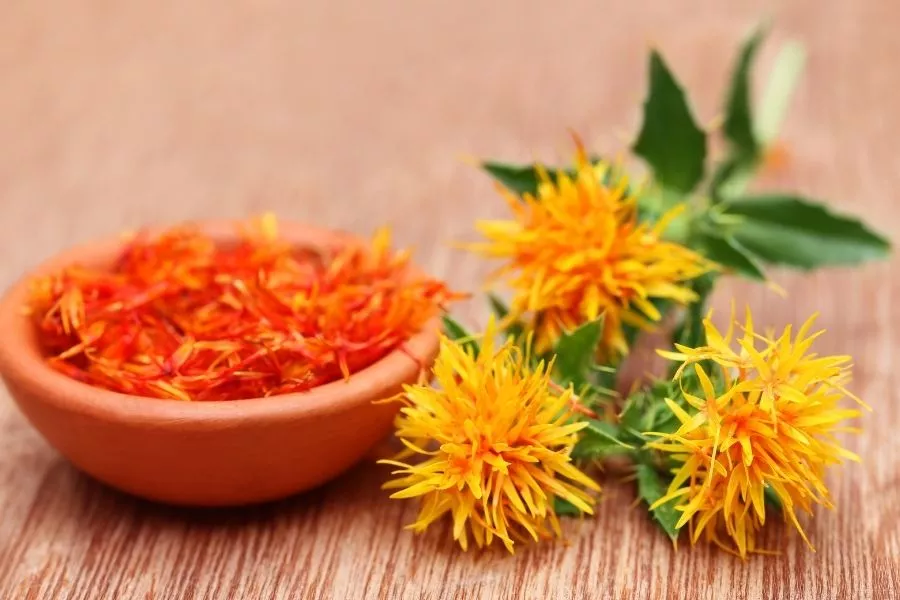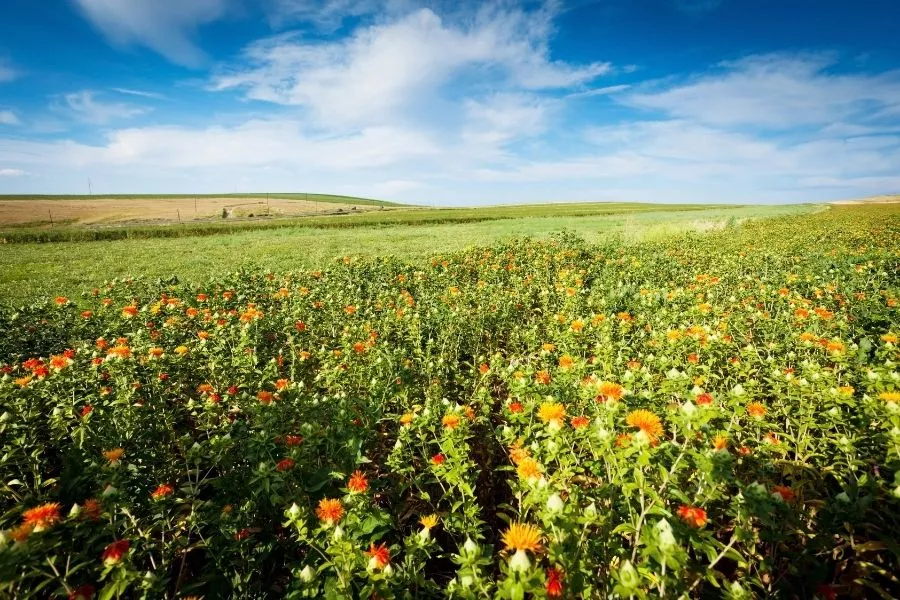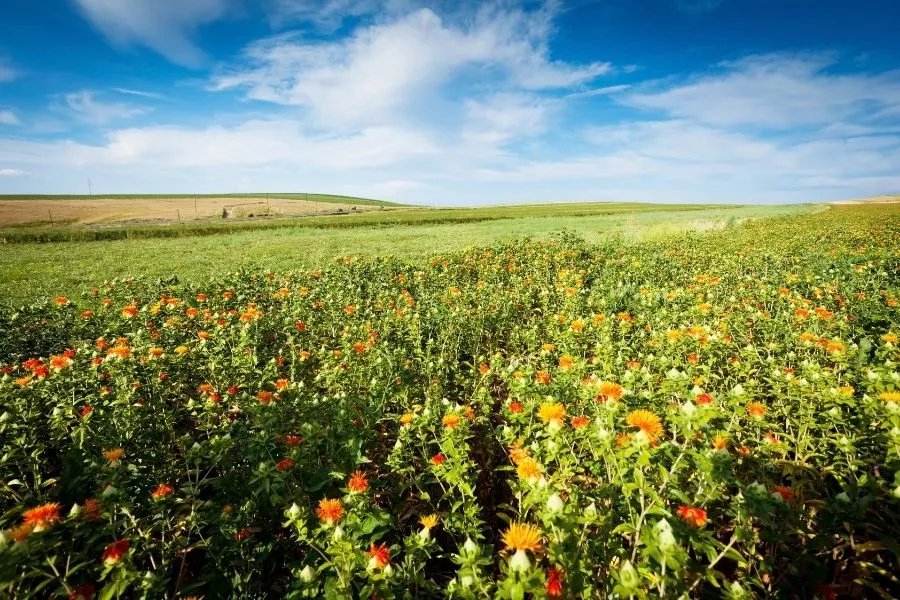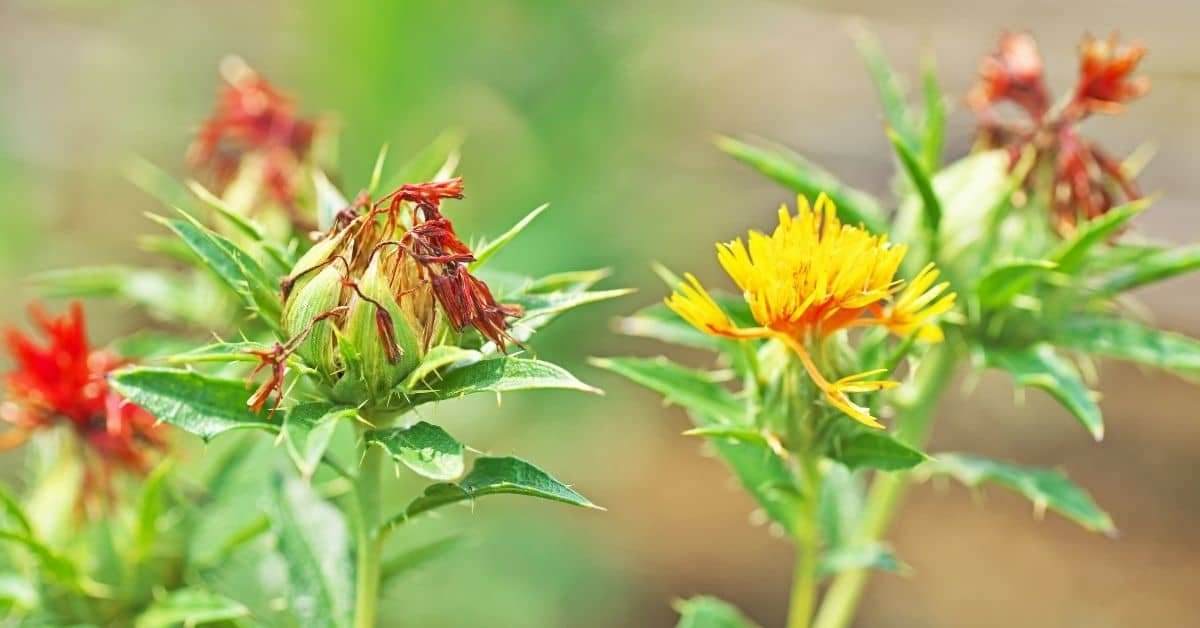How to grow safflower: Safflower is an annual herbaceous thistle-like plant in the Asteraceae family. It was employed as a saffron replacement by the early Spanish colonies along the Rio Grande.
Safflower
- Local Name: Karadi, Kusum, Kardai, Kusumbha.
- Family: Compositae.
- Botanical Name: Carthamus tinctorius.
- Origin: Abyssinia and Afghanistan.
Economic importance/Uses

Safflower was initially produced for its blooms, which were used to color clothing and food. However, it is now farmed mostly for the oil, but also for meal, birdseed, and feet (oil processing waste).
Linoleic safflower oil has about 75% linoleic acid, more than corn, soybean, cottonseed, peanut, or olive oils. This safflower is used to make salad oils and soft margarine. Whether polyunsaturated oils like linoleic acid can lower blood cholesterol and the concomitant heart and circulatory disorders are debated. As a result of public concern, safflower has become an important crop for vegetable oil.
High oleic acid varieties can be used to fry potato chips and french fries. It is a drying or semi-drying oil used in the manufacture of paints and other surface coatings. It is utilized in white and light-colored paints because it does not yellow with age. This oil can also be used to replace diesel fuel, although it is now too expensive to do so.
The meal left after oil extraction is fed to livestock as a protein source. The meal normally comprises 24% protein and lots of fiber. Decorticated meal (most hulls removed) is 40% protein with less fiber. Soap is made from feet. L’industrie des birdseeds ne s’approvisionne que Post-harvest grazing for sheep and cattle is possible. Other benefits of safflower are given below.
- Safflower is the most important rabi oilseed crop.
- It is grown mainly for edible oil and sometimes for dye purposes.
- The oil is good for heart patients as it contains polyunsaturated fatty acids.
- It is drying oil and hence used to manufacture paints, varnishes, waterproofing material, adhesives for glass, etc.
- The oil cake from decorticated seed is fed to cattle.
- The leaves of young plants are used as a vegetable.
- Red and yellow dye obtained from the flower heads is used for coloring cloths.
- It is grown as a border crop to protect the main crop from domestic animals.
- Dried stalks are used as fuel or for making paper.
- The oil content of safflower is about 28 to 30 p.c.
- Safflower oil does not increase the cholesterol level in human blood and is, hence, good for health.
Variety: N628, Sharda, Tara, Bhima, CT11, N300, N7, Nira.
How to Grow Safflower

A growing season of less than 120 frost-free days and 2,200 growing degree days is not recommended for safflower cultivation. Frost injury occurs after stem elongation till crop maturity. Safflower is tolerant to temperatures as low as 20°F while in the rosette stage.
During flowering and seed-filling, this crop prefers warm temperatures and bright, dry circumstances. Humidity and rain diminish seed set and increase leaf spot and head rot disease incidence, lowering yields. So this crop is semiarid suited. Safflower cannot be grown in most of Minnesota and Wisconsin.
Climatic Requirement
- Safflower is grown in a cool and dry climate.
- It is a drought-resistant crop.
- It is grown as a rainfed crop in areas receiving about 1000 mm rainfall.
- High humidity and rainfall increase damage from fungal diseases.
Soil Requirement
Safflower thrives on deep, fertile, well-drained soils with the excellent water-holding ability and stored moisture. Soils of low water-holding capacity can still yield this crop if properly irrigated. Crusty soils can hinder stand establishment. Soil salinity can reduce seed germination, yield, and oil content. Safflower is tolerant of soil salinity similar to barley.
- Safflower comes up well in well-drained, fertile medium to heavy soils.
- It is grown on light alluvial and loam soil as an irrigated crop.
- It is grown mainly on black cotton soils as an unirrigated crop.
Preparation of Land

Safflower requires one deep plowing in 3 years, followed by 2 to 3 harrowing. Collect the stubbles of the previous crop and prepare the clean seedbed. 5 to 10 tons FYM/ha. is added into the soil at the time of the last harrowing. As a mixed crop, safflower shares the preparatory tillage, manuring, and Intercultivation given to the main crop.
Sowing time: Safflower is sown in October – November.
Seed rate: As mixed crop: 8 to 15 kg/ha. As pure crop: 20 to 25 kg/ha. Spacing
- 45 X 20 cm (Rainfed).
- 60 X 30 cm (Irrigated).
Seed treatment: To control seed-borne diseases, sowing is done with thiram @ 3g or captan @ 2.5 g/kg.
Fertilizer Application:
5 to 10 tons FYM/ha. is added into the soil at the time of the last harrowing. The dose of fertilizer is
- Rainfed safflower: 25 kg N/ha.
- Irrigated safflower: 50 kg N, 25 kg P2O5/ha.
Rainfed crop fertilizers should be applied at the time of sowing. In the case of the irrigated crop, the half dose of N and all P should be applied at the time of sowing and the remaining half dose of N at 30 days after sowing.
Irrigation:
Safflower is a drought-resistant crop hence generally grown as a rainfed crop on stored moisture. As an irrigated crop, first irrigation is given before sowing. The other irrigations should be given at the flowering and grain filling stage, 35 to 40 days, and 65 to 70 days after sowing.
Crop Rotation
- Rotations followed in safflower are i) Bajra /Jowar– Safflower. ii) Mung/Udid– Safflower. iii) Groundnut– Safflower.
- It is grown as a mixed crop with wheat, gram, rabi jowar, etc.
- It is also grown as an intercrop and border crop.
- As inter-crop, one to two rows of safflower is altered with six rows of main crop (2:6).
Intercultural Operation:

It receives the intercultural operations done for the main crop as mixed or intercrop. Two thinning after 10 days and 20 days after sowing should be done as a pure crop to keep proper spacing. One weeding and 2 hoeings should be given at 15-day intervals to remove weeds and alter the soil. At the age of 45 to 60 days, the tops of the plants are cut down, called topping. The operation is carried out for more branching, flowering, and ultimate yield.
Safflower provides choices for weed and disease management, as well as exploiting soil moisture available to its deep taproot. Usually cultivated with tiny grains or fallow. Broadleaf herbicides used on small grains early in the cycle can severely harm safflower. Growing safflower after tiny grains requires caution.
Sunflower, mustard, canola (oilseed rape), and dry bean are subject to Sclerotinia head rot (white mold). Growing a crop after safflower requires a large replenishment of soil moisture. Safflower harvest leaves little crop leftover. This may help prevent soil erosion from wind and water erosion. Safflower farming is similar to small grain production.
Weeds can significantly reduce safflower crop production. Early-season weed control is critical. Growing a dense canopy of vegetation permits safflower to compete well with late-emerging weeds. In a limited grain rotation, safflower can be used with tillage and herbicides not intended for cereal grains to minimize grassy weeds.
Pests and Diseases Control
Diseases have wreaked havoc in years with above-average rainfall and extended high humidity. The most dangerous diseases are Alternaria leaf spot (Alternaria carthanti) and bacterial blight (Pseudomonas syringae). It causes big, brown irregular patches on leaves and flower bracts. Leaf spot resistance varies among varieties, and significant losses can occur.
Bacterial blight symptoms are comparable to Alternaria leaf spot symptoms and frequently emerge after heavy rain. Yellow-green leaf lesions. Using disease-free seed from a resistant variety and treating it properly before planting should help. Rust (Puccinia carthand) is easily controlled by seed treatment in safflower.
Other diseases that can cause economic losses have not been an issue in recent years in North Dakota. These include Sclerotinia and Botrytis flower head rots, Phytophthora and Pythium root rots, and Verticillium or Fusarium wilts. To reduce disease concerns, safflower should be rotated with safflower, sunflower, canola, mustard, dry bean, soybean, or lentils every four years. Safflower disease concerns have historically been severe in humid, rainy areas east of the Dakotas.
Important pests of safflower fly, leaf-cutting caterpillar, aphids.
- Spraying of 0.07% endosulfan or 0.05% Malathion for the fly.
- Dusting of 10% Carbaryl @ 20 kg/ha or spraying 0.05% endosulfan for leaf-cutting caterpillar.
- Spraying of 0.03% Dimethoate or 0.02% thiometon for two times at 15 days intervals or Dusting of 10% Carbaryl or 4% endosulfan @ 20 kg/ha. For aphids.
Safflower can repair bug damage nicely. Economic losses are rare unless the stands are severely diminished. Beneficial insects like bees are drawn to safflower during flowering and help seed establishment by pollinating.
Wireworms, cutworms, and seed corn maggots can injure seedlings. Seed treatment is good control. Wireworms can be treated using Lindane or fungicides applied prior to sowing. It may be harmed subsequently by thrips and lygus bugs. These pests should only be controlled if they are causing substantial damage.
Severe insect damage early in the flowering cycle might cause premature senescence of Rower heads (bronzebeads), resulting in 20-30% crop loss. Producers should examine all available cultural and chemical insect pest management options. Seek advice from your county Extension agent.
Important diseases of safflower are rust and bacterial leaf blight.
- Treat the seed with thiram @ 3 g/kg or captan 2.5 g/kg seed or Spray 0.3% dithane M45 at 15 days intervals for 3 to 4 times for rust disease.
- For Bacterial Blight, Spray streptocyclin 500 ppm 2 to 3 times.
Harvesting:
Safflower is ready to harvest when most of the leaves turn brown and the bracts of the latest flowering heads are barely green. The seeds should be white and easily threshed. To avoid seed discoloration or sprouting in the head caused by fall rains, harvest this crop as soon as it matures.
Safflower stands well and does not shatter readily, making it ideal for straight blending. This method requires artificial drying or waiting for the frost to kill green weeds. Windrowing can be used to dry green weeds with a moisture content of 25%. Harvesting safflower in North Dakota and other parts of the Upper Midwest can occur from early September to late September depending on growth conditions.
The safflower matures in about 120 to 125 days for grain purposes. It is harvested after drying the leaves and capsules. Harvesting is carried out by uprooting the plants or cutting near the ground early in the morning when there is dew on the plants. The plants are heaped for a few days for drying.
Collection of Dye from Flowers:
The flower heads are plucked at 2 to 3-day intervals and dried for dye purposes. The ray florets and disc florets are collected. The yellow dye is obtained by dissolving them in water. The remaining pulp is dried and made into small cubes and used for obtaining saffron red dye. The saffron red dye is obtained by dissolving them in alkali. The dye is used for coloring the clothes.
Post-harvest operation:
Dried plants are threshed by beating with a stick and winnowed to obtain clean seeds. The flower heads are plucked every 2 days after flowering for dye purposes.
Yield:
- Mixed crop: 125 kg/ha.
- Sole crop: 500 to 800 kg/ha.
- Dye purpose: 100 to 150 kg dried petals/ha.
